PORSCHE PANAMERA 2009 1.G Information Manual
Manufacturer: PORSCHE, Model Year: 2009, Model line: PANAMERA, Model: PORSCHE PANAMERA 2009 1.GPages: 343, PDF Size: 7.96 MB
Page 181 of 343

Driving and Driving Safety
179
Radiofrequency radiation exposure
Information
This equipment complies with FCC radiation
exposure limits set forth for an uncontrolled
environment. This equipment should be installed
and operated with minimum distance of 8 in.
(20 cm) between the radiator and your body.
This transmitter must not be co-located or
operating in conjunction wi th any other antenna or
transmitter
Warning!
Risk of accidents. Rada r sensor vision can be
impaired by rain, snow, ice or heavy spray.
Vehicles in front will not be detected properly
or may not be detected at all.
f Do not use adaptive cruise control under these conditions.
Warning message
Adaptive cruise control can be deactivated
automatically if the radar sensor is very dirty or
iced up, obstructed , in unfavorable weather
conditions (heavy rain) or when driving through
tunnels.
The message “Fault ACC sensor” will appear on
the multi-function display in the instrument panel.
For information on warning messages on the
multi-function display:
f Please see the chapter “OVERVIEW OF
WARNING MESSAGES” on page 152. Notes
This device complies with Part 15 of the FCC
Rules and with RSS-210 of Industry Canada.
Operation is subject to the following two
conditions:
1. This device may not cause harmful
interference, and
2. this device must accept any interference received, including interference that may
cause undesired operation.
Changes or modifications made to this equipment
not expressly approved by Porsche may void the
FCC authorization to operate this equipment.
This equipment has been tested and found to
comply with the limits for a Class A digital device,
pursuant to Part 15 of the FCC Rules. These limits
are designed to provide reasonable protection
against harmful interference when the equipment
is operated in a commercial environment. This
equipment generates, uses, and can radiate radio
frequency energy and, if not installed and used in
accordance with the instruction manual, may
cause harmful interference to radio
communications. Operation of this equipment in a
residential area is likely to cause harmful
interference in which case the user will be required
to correct the interferen ce at his own expense.
This Class A digital apparatus complies with
Canadian ICES-003.
Cet appareil numérique de la classe A est
conforme à la norme NMB-003 du Canada.
Operating principle of adaptive cruise
controlNo vehicle detected in front – open road
driving
Adaptive cruise control operates like a cruise
control system. The desired speed that was set is
maintained constantly.
Vehicle detected in front – driving in traffic
If a vehicle travelling ahead of you in the same lane
is detected as driving slower than the selected
desired speed, adaptive cruise control will
automatically maintain a set distance from the
vehicle in front.
If the vehicle in front stop s, adaptive cruise control
will slow your vehicle down to a stop provided this
is possible within the cont rol limits of the system.
Adaptive cruise control actively keeps your vehicle
at a standstill.
If the vehicle in front drives off, automatic speed
control and distance control can be resumed.
Page 182 of 343
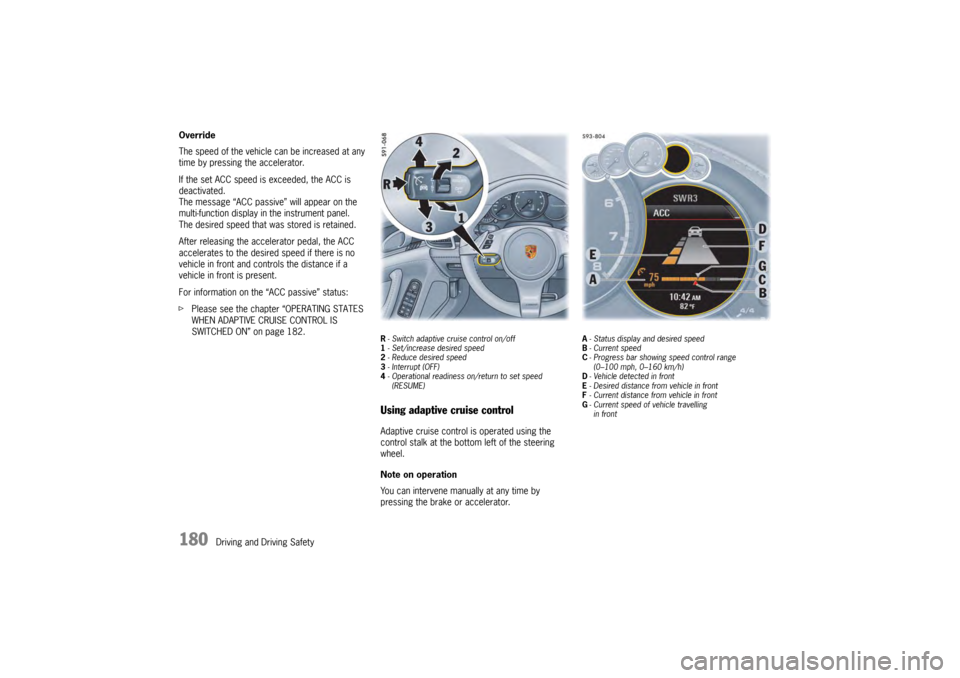
180
Driving and Driving Safety
Override
The speed of the vehicle can be increased at any
time by pressing the accelerator.
If the set ACC speed is exceeded, the ACC is
deactivated.
The message “ACC passive” will appear on the
multi-function display in the instrument panel.
The desired speed that was stored is retained.
After releasing the accelerator pedal, the ACC
accelerates to the desired speed if there is no
vehicle in front and controls the distance if a
vehicle in front is present.
For information on the “ACC passive” status:
f
Please see the chapter “OPERATING STATES
WHEN ADAPTIVE CRUISE CONTROL IS
SWITCHED ON” on page 182.
R- Switch adaptive cruise control on/off
1 - Set/increase desired speed
2 - Reduce desired speed
3 - Interrupt (OFF)
4 - Operational readiness on/return to set speed
(RESUME)Using adaptive cruise controlAdaptive cruise control is operated using the
control stalk at the bottom left of the steering
wheel.
Note on operation
You can intervene manually at any time by
pressing the brake or accelerator.
A - Status display and desired speed
B - Current speed
C - Progress bar showing speed control range
(0–100 mph, 0–160 km/h)
D - Vehicle detected in front
E - Desired distance from vehicle in front
F - Current distance from vehicle in front
G - Current speed of vehicle travelling
in front
Page 183 of 343
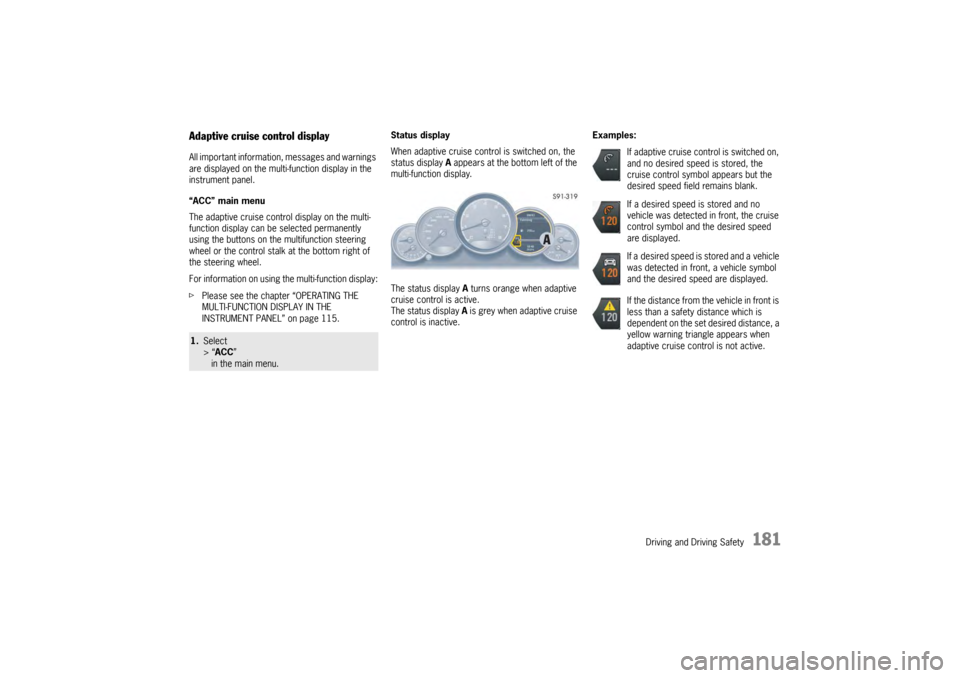
Driving and Driving Safety
181
Adaptive cruise control displayAll important information, messages and warnings
are displayed on the multi-function display in the
instrument panel.
“ACC” main menu
The adaptive cruise control display on the multi-
function display can be selected permanently
using the buttons on the multifunction steering
wheel or the control stalk at the bottom right of
the steering wheel.
For information on using the multi-function display:
f Please see the chapter “OPERATING THE
MULTI-FUNCTION DISPLAY IN THE
INSTRUMENT PANEL” on page 115. Status display
When adaptive cruise control is switched on, the
status display
A appears at the bottom left of the
multi-function display.
The status display A turns orange when adaptive
cruise control is active.
The status display A is grey when adaptive cruise
control is inactive. Examples:1.
Select
> “ACC ”
in the main menu.
If adaptive cruise control is switched on,
and no desired speed is stored, the
cruise control symbol appears but the
desired speed field remains blank.
If a desired speed is stored and no
vehicle was detected in front, the cruise
control symbol and the desired speed
are displayed.
If a desired speed is stored and a vehicle
was detected in front, a vehicle symbol
and the desired speed are displayed.
If the distance from the vehicle in front is
less than a safety distance which is
dependent on the set desired distance, a
yellow warning triangle appears when
adaptive cruise control is not active.
Page 184 of 343

182
Driving and Driving Safety
Switching adaptive cruise control on
and offSwitching adaptive cruise control on
fPress button R on the control stalk.
The grey status display appears on the
multi-function display.
Adaptive cruise control is ready.
Switching adaptive cruise control off
f Press button R on the control stalk.
“ACC off” appears on the multi-function
display.
The desired speed that was stored is deleted.
The desired distance is set to the default value.Operating states when adaptive cruise
control is switched onThere are three possible operating states when
adaptive cruise control is switched on.
Adaptive cruise control active
Adaptive cruise control automatically regulates
the speed and distance fr om the vehicle in front.
The status display A turns orange. Adaptive cruise control is ready
Cruise control and distance control is inactive
after pressing the brakes or interrupting by
pressing the control stalk down (position
3, OFF ).
The desired speed that was stored and the
desired distance that was set are retained.
The status display A turns grey.
Adaptive cruise control is active again after
you release the accelerator.
For information on resuming cruise control and
distance control:
f Please see the chapter “RESUMING CRUISE
CONTROL AND DISTANCE CONTROL –
RESUME” on page 185.
Adaptive cruise control passive
Cruise control and distance control is inactive
after pressing the accelerator.
“ACC passive” appears on the multi-function
display.
The desired speed that was stored and the
desired distance that was set are retained.
The status display A turns grey.
Adaptive cruise control is active again after
you release the accelerator.
Setting and changing the desired speedPreconditions
– ACC is switched on.
– Vehicle is moving.
– No stationary objects are detected in front.
Setting the desired speed
1. Press the control stalk on the steering wheel forward (position 1).
The current driving speed is stored as the
desired speed, which will be maintained
automatically (within the control range from 20
to 100 mph, 30 to 210 km/h), and appears
orange in the status display A.
The red triangle B under the progress bar for
the speed control range shows the speed of
your vehicle.
2. Release the accelerator pedal. The desired speed is maintained automatically
unless a vehicle travelling in front is detected
as driving slower than the desired speed.
Note
If your vehicle is stopped, the message
“Impossible when parked” appears on the multi-
function display when you press the control stalk
forward (position 1).
If a stationary object wa s detected in front, the
message “Stationary ob ject” appears on the
multi-function display.
Page 185 of 343
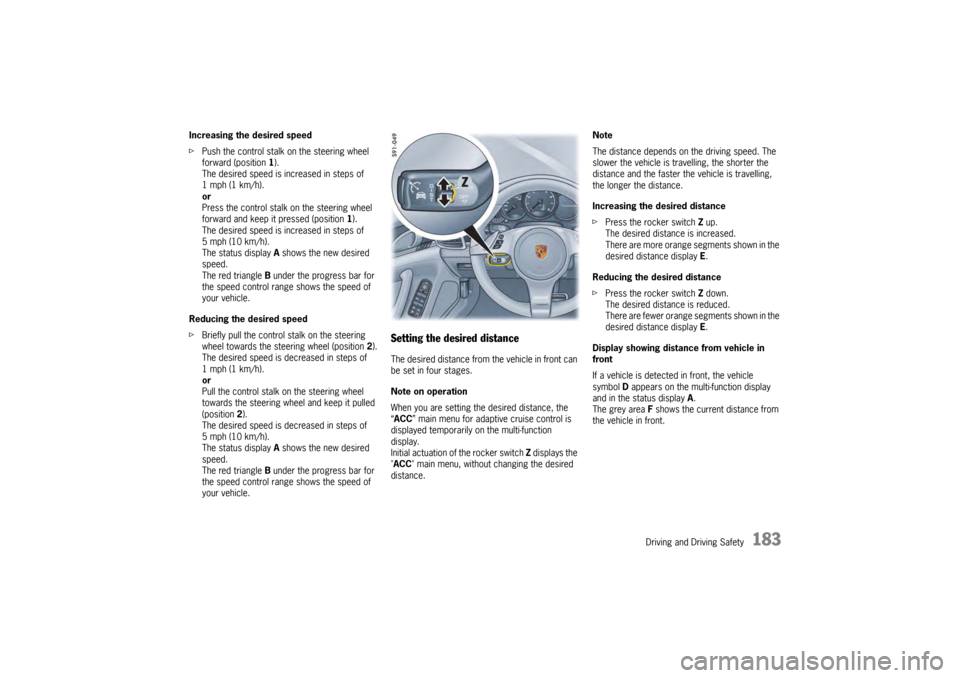
Driving and Driving Safety
183
Increasing the desired speed
fPush the control stalk on the steering wheel
forward (position 1).
The desired speed is increased in steps of
1mph (1km/h).
or
Press the control stalk on the steering wheel
forward and keep it pressed (position 1).
The desired speed is increased in steps of
5 mph (10 km/h).
The status display A shows the new desired
speed.
The red triangle B under the progress bar for
the speed control range shows the speed of
your vehicle.
Reducing the desired speed
f Briefly pull the control stalk on the steering
wheel towards the steering wheel (position 2).
The desired speed is decreased in steps of
1mph (1km/h).
or
Pull the control stalk on the steering wheel
towards the steering wheel and keep it pulled
(position 2).
The desired speed is decreased in steps of
5 mph (10 km/h).
The status display A shows the new desired
speed.
The red triangle B under the progress bar for
the speed control range shows the speed of
your vehicle.
Setting the desired distanceThe desired distance from the vehicle in front can
be set in four stages.
Note on operation
When you are setting the desired distance, the
“ ACC ” main menu for adaptive cruise control is
displayed temporarily on the multi-function
display.
Initial actuation of the rocker switch Z displays the
"ACC " main menu, without changing the desired
distance. Note
The distance depends on the driving speed. The
slower the vehicle is travelling, the shorter the
distance and the faster the vehicle is travelling,
the longer the distance.
Increasing the desired distance
f
Press the rocker switch Z up.
The desired distance is increased.
There are more orange segments shown in the
desired distance display E.
Reducing the desired distance
f Press the rocker switch Z down.
The desired distance is reduced.
There are fewer orange segments shown in the
desired distance display E.
Display showing distance from vehicle in
front
If a vehicle is detected in front, the vehicle
symbol D appears on the multi-function display
and in the status display A.
The grey area F shows the current distance from
the vehicle in front.
Page 186 of 343

184
Driving and Driving Safety
Possible distance settings
Automatic braking to a stopIf the vehicle in front stops, adaptive cruise control
will slow your vehicle down
to a stop provided this
is possible within the control limits of the system.
The display lights up on the instrument panel.
The vehicle is actively held at a stop.
For information on the HOLD function:
f Please see the chapter “HOLD FUNCTION:
DRIVE-OFF ASSISTANT AND STANDSTILL
MANAGEMENT” on page 206.
Note
Depending on the traffic flow, e.g. slow moving
traffic, stopping is initiated by a slow crawling
phase which ends in vehicle standstill.
Caution!
Brake pedal feels different. When adaptive
cruise control is operating normally or when
the HOLD function is active, the brake pedal
may feel different and you may hear
hydraulic noises.
This behavior is no rmal for the system.
It is not a fault.
Driving off againThe vehicle can be driven off again after being
stopped and speed and distance control will be
resumed, depending on the operating state of the
adaptive cruise control system.
For information on the operating states of the
adaptive cruise control system:
fPlease see the chapter “OPERATING STATES
WHEN ADAPTIVE CRUISE CONTROL IS
SWITCHED ON” on page 182.
Adaptive cruise control active
1. Press the control stalk on the steering wheel up (position 4, RESUME ).
2. Briefly press the accelerator pedal. Your vehicle drives on automatically.
Note
Your vehicle will not drive off if the vehicle
detected in front is stationary.
Adaptive cruise control is ready
Automatic speed and distance control can only
be resumed when your vehicle is moving.
1. Drive off normally.
2. Press the control stalk on the steering wheel up (position 4, RESUME ).
or
Set or change the desired speed.
Suitable for speedy driving in lines of
traffic. The time headway is 1 second.
This corresponds to 36 yd. (33 meters)
at a speed of 75 mph (120 km/h).
Suitable for driving comfortably in lines
of traffic. The time headway is
1.3 seconds. This corresponds to
47 yd. (43 meters) at a speed of
75 mph (120 km/h).
Preset distance
Corresponds to the general
recommendation of the road traffic
safety regulation (“two seconds time
headway”). The time headway is
1.8 seconds. This corresponds to
66 yd. (60 meters) at a speed of
75 mph (120 km/h).
Suitable for driving on country roads.
The time headway is 2.3 seconds.
This corresponds to 63 yd. (58 meters)
at a speed of 56 mph (90 km/h).
Page 187 of 343
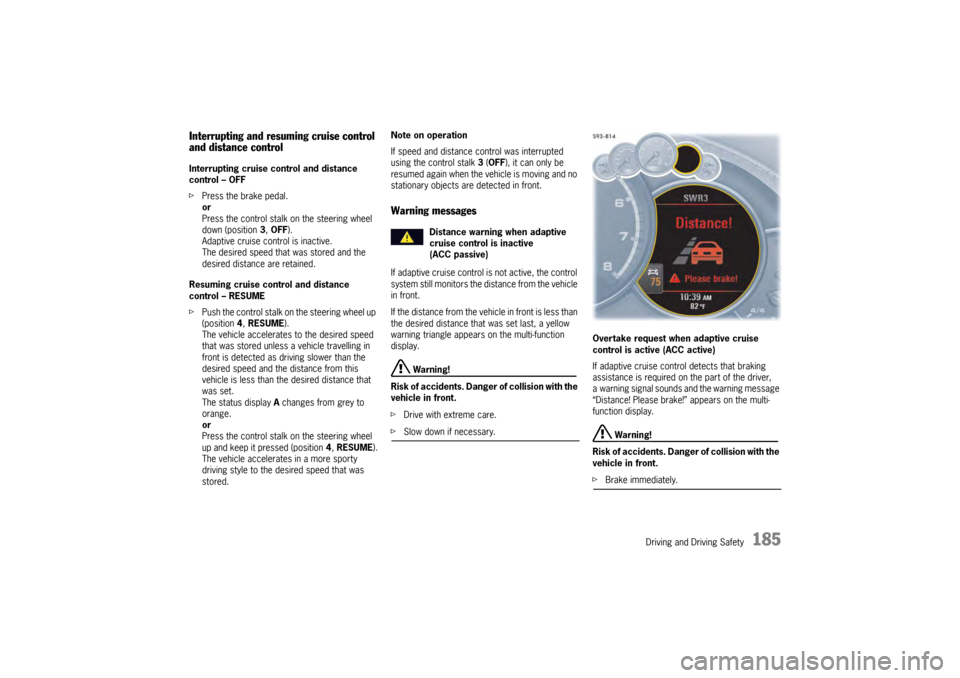
Driving and Driving Safety
185
Interrupting and resuming cruise control
and distance controlInterrupting cruise control and distance
control – OFF
fPress the brake pedal.
or
Press the control stalk on the steering wheel
down (position 3, OFF ).
Adaptive cruise control is inactive.
The desired speed that was stored and the
desired distance are retained.
Resuming cruise control and distance
control – RESUME
f Push the control stalk on the steering wheel up
(position 4, RESUME).
The vehicle accelerates to the desired speed
that was stored unless a vehicle travelling in
front is detected as driving slower than the
desired speed and the distance from this
vehicle is less than the desired distance that
was set.
The status display A changes from grey to
orange.
or
Press the control stalk on the steering wheel
up and keep it pressed (position 4, RESUME).
The vehicle accelerates in a more sporty
driving style to the desired speed that was
stored. Note on operation
If speed and distance control was interrupted
using the control stalk
3 (OFF ), it can only be
resumed again when the vehicle is moving and no
stationary objects are detected in front.
Warning messagesIf adaptive cruise control is not active, the control
system still monitors the distance from the vehicle
in front.
If the distance from the ve hicle in front is less than
the desired distance that was set last, a yellow
warning triangle appears on the multi-function
display.
Warning!
Risk of accidents. Danger of collision with the
vehicle in front.
f Drive with extreme care.
fSlow down if necessary. Overtake request when adaptive cruise
control is active (ACC active)
If adaptive cruise control detects that braking
assistance is required on the part of the driver,
a warning signal sounds and the warning message
“Distance! Please brake!” appears on the multi-
function display.
Warning!
Risk of accidents. Danger of collision with the
vehicle in front.
f Brake immediately.
Distance warning when adaptive
cruise control is inactive
(ACC passive)
Page 188 of 343

186
Driving and Driving Safety
Exceptions for adaptive cruise control
Adaptive cruise control is
not available in the
following situations:
– If the ignition is switched off.
– When PSM is off.
– If the driver’s door is opened and the driver’s seat belt is not fastened.
– When parking or maneuvering in very tight spaces.
– If the PDK selector lever is at position N, R or
P .
– On upward or downward slopes of more than 20 %.
– When the electric parking brake is activated.
If one of these exception situations occurs when
adaptive cruise control is switched on, adaptive
cruise control will be switched off.
A message to this effect will appear on the
multi-function display. Messages on the multi-function display
If adaptive cruise control was deactivated
automatically or if an action cannot be performed,
a message to this effect in blue appears on the
multi-function display.
–“
ACC not available! ”
Adaptive cruise control is not available,
e.g. when maneuvering.
–“ ABS/PSM intervention!”
Adaptive cruise control was deactivated
because ABS or PSM intervened as a control
mechanism.
–“ Electric parking brake! ”
Adaptive cruise control was deactivated
because the electric parking brake was
activated.
–“ Selector position!”
Adaptive cruise control was deactivated
because the PDK select or lever is not in
position D or manual position M.
–“ Impossible while parked ”
The required action is not possible because
your vehicle is stationary, e.g. when setting
a desired speed.
–“ Speed! ”
Adaptive cruise control was deactivated
because the rpm limit of the engine was
reached in manual position M of the PDK
selector lever. –“
Gradient too steep! ”
The desired distance or the desired speed
cannot be set because the gradient on the
road is too steep.
–“ Stationary object ”
The action is not possi ble because a stationary
object was detected ahead.
–“ PSM off! ”
Adaptive cruise control is not available
because PSM was switched off.
For information on Porsche Stability
Management (PSM):
f Please see the chapter “PORSCHE STABILITY
MANAGEMENT (PSM)” on page 202.
General information“Sport” and “Sport Plus” mode
Adaptive cruise control regulates your driving
more dynamically in “Sport” and “Sport Plus”
mode.
Page 189 of 343
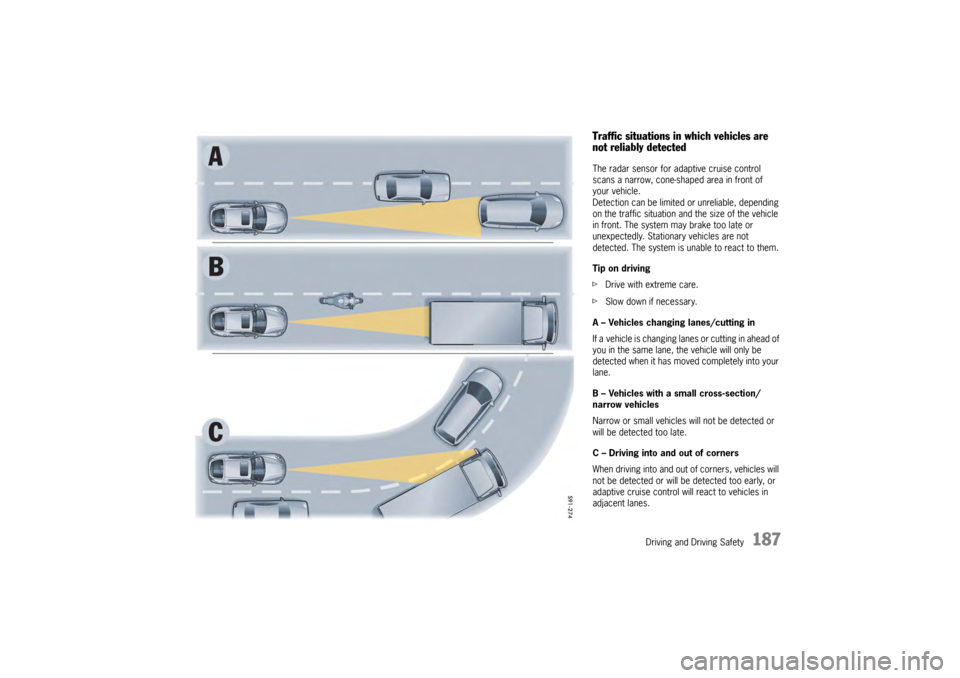
Driving and Driving Safety
187
Traffic situations in which vehicles are
not reliably detectedThe radar sensor for adaptive cruise control
scans a narrow, cone-shaped area in front of
your vehicle.
Detection can be limited or unreliable, depending
on the traffic situation and the size of the vehicle
in front. The system may brake too late or
unexpectedly. Stationary vehicles are not
detected. The system is unable to react to them.
Tip on driving
fDrive with extreme care.
f Slow down if necessary.
A – Vehicles changing lanes/cutting in
If a vehicle is changing la nes or cutting in ahead of
you in the same lane, th e vehicle will only be
detected when it has moved completely into your
lane.
B – Vehicles with a small cross-section/
narrow vehicles
Narrow or small vehicles will not be detected or
will be detected too late.
C – Driving into and out of corners
When driving into and out of corners, vehicles will
not be detected or will be detected too early, or
adaptive cruise control will react to vehicles in
adjacent lanes.
Page 190 of 343
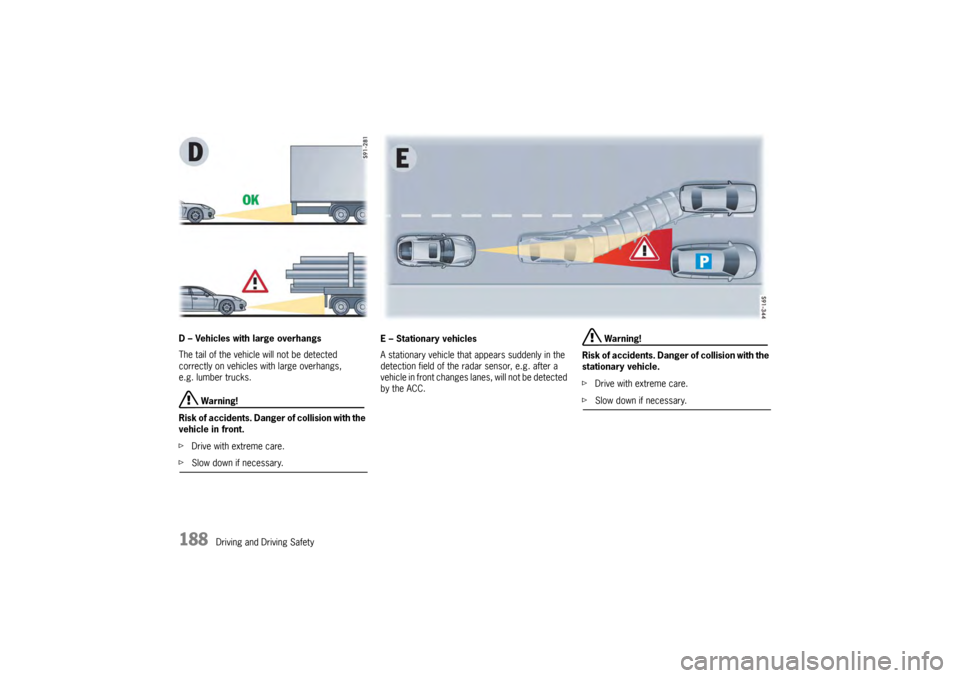
188
Driving and Driving Safety
D – Vehicles with large overhangs
The tail of the vehicle will not be detected
correctly on vehicles with large overhangs,
e.g. lumber trucks.
Warning!
Risk of accidents. Danger of collision with the
vehicle in front.
f Drive with extreme care.
fSlow down if necessary.
E – Stationary vehicles
A stationary vehicle that appears suddenly in the
detection field of the radar sensor, e.g. after a
vehicle in front changes lanes, will not be detected
by the ACC.
Warning!
Risk of accidents. Danger of collision with the
stationary vehicle.
f Drive with extreme care.
fSlow down if necessary.